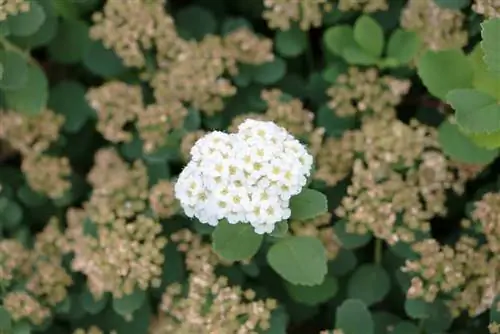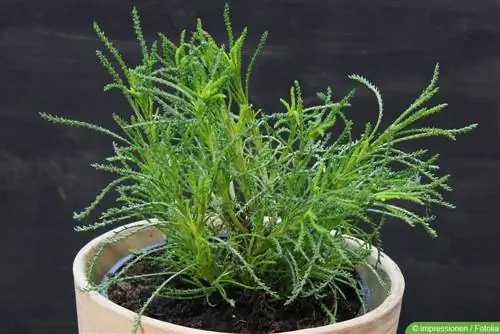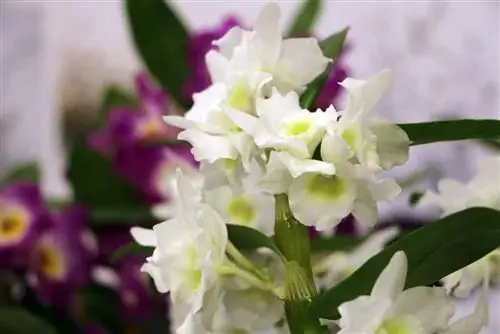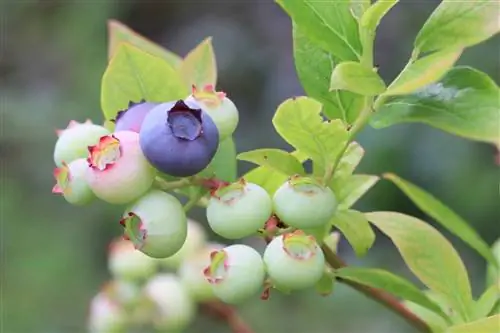- Author admin [email protected].
- Public 2023-12-17 03:39.
- Last modified 2025-06-01 06:48.
As a multilateral plant genus, the spar shrub impresses with multifaceted species, from compact ground cover to majestic solitary plants. Always covered in colorful flowers from spring to summer. Novice gardeners can hardly believe their luck when they explore the many talents of a spar.
The hardy, summer-green ornamental shrub thrives in almost any location without requiring demanding care. Get to know all the central aspects of planting, cutting and propagation here and join the large following.
Profile
- Plant family Rosaceae
- Spiraea genus
- hardy ornamental shrubs with summer-green foliage
- Growth height from 25 to 300 cm
- depending on the species, the flowers bloom in spring or summer
- very dense inflorescence in panicles, racemes or umbels
- Alternative foliage in rich green or golden yellow
- toothed leaf edges as a typical feature
Originally native to the Eastern European-Asian region, the spar also appears wild in the local regions in forest clearings, in meadows, along rivers and streams as well as in riparian and swampy forests. In contrast to the cultivated varieties, the wild forms develop sparser flowers.
Location
The spar thrives in any normal garden soil with an average moisture content. Depending on the variety, dry areas in the rock garden are just as acceptable as moist areas on the banks of the garden pond. The only thing the tree cannot cope with is permanent waterlogging. The spar shrub is similarly flexible when it comes to lighting conditions. Sunny to partially shaded is considered optimal. The darker the location, the fewer the flowers.
Plants
The best time to plant the spar bush is in spring, during the months of April to May. Forward-looking hobby gardeners wait for the Ice Saints to arrive in mid-May, because experience shows that from this point onwards there will no longer be any frost on the ground. Planting in autumn is also possible. In the soil that is still warm in summer, the roots spread quickly and are well established when winter sets in.
Preparation and insertion
There is no need for a long, dedicated search for a suitable planting site when cultivating a spar. However, the following preparatory work on the soil is recommended so that the wood grows quickly:
- Thoroughly loosen the soil.
- Clean from roots, stones and weeds.
- Incorporate a portion of ripe compost with horn shavings.
- Dig a planting pit with 1.5 times the volume of the root ball.
- Create a drainage system using crushed pottery shards, gravel, grit or expanded clay.
During this work, the root ball of the flowering bush is allowed to soak up water in a container. Place the now potted spar in the middle of the planting hole. In the end, the tree is only a little deeper than in the container. After watering, a layer of mulch made from compost, grass clippings, leaf mold or pieces of bark is recommended.
Tip:
If the root ball comes out of the container very compacted, score it in a cross shape with a cutter knife of approx. 0.5 cm.
Cutting

The main focus of adequate care is an annual thinning and maintenance cut. This measure maintains the vitality of a spar for many years. At the same time, pruning gives the creative hobby gardener the opportunity to give the ornamental shrub the desired shape. Fortunately, the spar bush is extremely easy to cut and quickly forgives the odd beginner's mistake due to its lush growth. The time at which the cut takes place determines the flowering time of a Spiraea species. Spring-blooming plants become acquainted with pruning shears immediately after flowering, while summer-flowering plants are only trimmed the following spring. The actual incision is the same in both cases.
- Cut out all dead wood completely.
- Cut sickly, weak branches at the base.
- Cut obviously frozen shoots down to the he althy wood.
- Completely remove branches that point towards the interior of the bush.
- Do the same with criss-crossing branches.
- Short the remaining shoots to the desired length.
An ideal cut moves the scissors at a slight angle, with the individual cut starting just above an outward-facing bud. Only use freshly sharpened, meticulously disinfected tools. Bruises on the wood open the door to lurking fungal spores, viruses and pests for an infestation. The rule of thumb is: the more vigorous the pruning, the stronger the newly sprouting branches will be. A conservative pruning promotes the development of numerous young shoots, which, however, grow shorter and less robustly.
Propagate
Cuttings
The annually recurring shape and maintenance pruning also provides plenty of propagation material in the form of cuttings. All he althy, semi-woody specimens with a length of 15 cm are suitable. These are stripped of their leaves except for the upper pair of leaves. Any buds should also be cut off because they consume a lot of energy. Plant the prepared cuttings in small cultivation pots that are filled with lean substrate, such as peat sand, perlite or coconut fiber. In order to create the required warm, humid microclimate, the indoor greenhouse is just as suitable as a free space in the greenhouse or winter garden. Alternatively, place a plastic bag over the container and support the cover with small wooden sticks so that it does not touch the cutting.
At 20 to 24 °C, the spar cuttings root quickly. The process can be recognized by the new shoots and the root strands that protrude from the opening in the ground. Then the time has come to repot the young plants in compost-based potting soil. From a height of 30 to 40 cm, the offspring are strong enough to be planted out.
Lowers
A variant of propagating cuttings that is suitable for beginners takes place directly in the bed. During the main growing season, select one or more one- to two-year-old branches that give a vital, he althy impression. This is how you continue with the lowering tools:
- Pull the shoot to the ground and make a 10 cm deep furrow there.
- Where the sinker and soil touch, remove the leaves from the bark and scratch lightly in several places with a razor blade.
- Dig in this area of the branch, press down the soil and water.
- The shoot tip can still be seen and is tied to a stable pole.
During the following weeks, each sinker develops its own root system from the wound tissue while being supplied with nutrients by the mother plant. If you feel significant resistance by pulling on the shoot, separate it from the bush and plant it in the new location.
Tip:
Lowers that spring back up are fixed in the ground with a wire, staple or tent peg.
Special features
- Flowering branches can be easily cut and last a long time in the vase.
- Flowers should be open when cut, because buds that are still closed will not open in the vase.
- Can also be kept in a pot.
Species
- Belgian Spiraea (Spiraea x vanhouttei): Blooms from May to June, height 150-200 cm; blooms with large umbels covered in white flowers; thin out after flowering; other cuts described below under pruning
- Bridal Spire Shrub - Bridal Spire (Spiraea x arguto): Height 150 cm; blooms from April to May with long panicles of snow-white flowers; Thin out after flowering, other cutting described below under pruning
- Japanese spiraea (Spiraea japonica varieties): Heavy pruning in spring (March or April) before budding to about a hand's breadth above the ground
- Low spirea bush (Spiraea decumbens): Heavy pruning in spring (March or April) before budding to about a hand's breadth above the ground
- Summer spar (Spiraea bumalda) (Spiraea thunbergii): Best-known species; Height 60-80 cm and just as wide; blooms from July to September with semicircular umbels consisting of small pink or white flowers with a slightly musty smell; also forms many ground shoots; Cut as described below under pruning; is particularly suitable as a hedge; is native to Asia
Varieties (selection)
- `Anthony Waterer: Summer Spiere.
- `Golden Princess: Summer Sparrow; blooms pink from June to July; is planted primarily for its yellow foliage; is considered particularly drought tolerant
Conclusion
Among the flagship plants for the easy-care hobby garden, the spar is rightly at the top of the best list. There is an appropriate Spiraea species for every need, from ground cover to impressive solitaires. Correct planting does not require a we alth of experience, nor does propagation through cuttings or planters. The focus of proper care is an annual shape and maintenance pruning, which keeps a lushly growing spar he althy and in the desired size.






